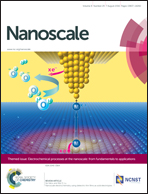Shape-controlled anisotropy of superparamagnetic micro-/nanohelices†
Abstract
Micro-/nanopropellers can be actuated remotely by a rotating magnetic field and steered at high precision through various fluidic environments. Recent progress comprises microfabrication of superparamagnetic microhelices not possessing remanent magnetization, but rather magnetized by an applied magnetic field. In this article we present a numerical approach for computing, from first principles, the effective susceptibility of polarizable helical micro-/nanopropellers. We show that nanopropeller geometry, in particular, filament cross-section elongation and orientation, play a central role in determining its magnetic anisotropy and polarizability. The numerical predictions are in qualitative agreement with the previously reported experiments, showing that tight polarizable helices are propulsive. The numerical results are also supported by the approximate slender-body theory. Finally, we propose a semi-quantitative energy criterion to rank polarizable helices with different geometries of the filament by their propulsive capacity and also estimate their maximal propulsion speed.


 Please wait while we load your content...
Please wait while we load your content...